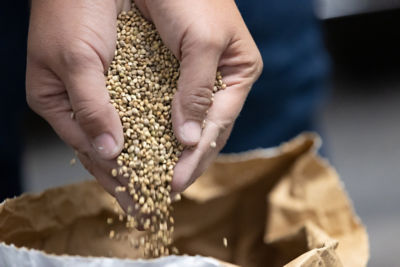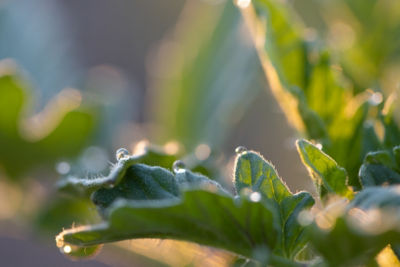Click here to download a PDF version of this Cultivation Insights article.
- Zucchini can be produced successfully in commercial greenhouse systems.
- Variety selection, light levels, temperatures, and plant densities are essential factors for greenhouse production.
- Sufficient male flower production and flower and fruit abortion can be problematic under some conditions.
While zucchini is not as commonly grown in protected culture as are crops such as cucumber, pepper, and tomato, zucchini can be successfully grown in commercial greenhouse production systems. Zucchini has a cropping cycle of 120 to 150 days, with 40 to 55 days from planting to first-harvest, 30 days under summer conditions. Two crops can be successfully grown per year in many areas.1,2 Under certain conditions it is possible to grow three crops per year.
Production Systems
Hydroponic production systems for zucchini are similar to those used for tomato and cucumber. Most growers use rock wool as the growth medium, and a few growers use coconut coir. Peat/perlite mixes can also be used, but this is less common. The growth medium is enclosed in bags, which are placed on the floor of the greenhouse. The standard bag size is 90 cm (35 inches) long, 30 cm (12 inches) wide, and 8 to 10 cm (3 to 4 inches) high.1,3 Zucchini can also be grown in soil-beds, but yields are usually lower than those with rockwool and coir systems. Even though zucchini plants have a bushy growth habit, rather than a viney habit, training systems are typically used to support vertical growth.
Plant Density
In the greenhouse, zucchini is usually planted in 6 rows per 8 m (8.7 yards) or 2 rows per 3.2 m (3.5 yards). The plant density used depends on the vigor and compactness of the variety grown and the light transmissibility of the greenhouse material. Wider spacings are often used in fall plantings because of lower light levels at the time of maximum fruit production.3
Plant densities used for zucchini range from 0.8 to 1.2 plants per square meter (1.0 to 1.4 plants per square yard), and higher density plantings have been studied.1,4 The number of fruit and total marketable yield per area increases as density increases, up to at least 2.1 plants per square meter.1,4,5 Higher density plantings tend to produce smaller fruit and more off-shaped fruit. Lower density plantings tend to produce more oversized fruit. The number of aborted flowers and fruit also have been shown to increase at higher planting densities in some studies.4
Growing Conditions
Recommended temperatures for a spring crop of zucchini change with the age of the crop. For the first week after transplanting, day and nighttime temperatures should be maintained at 20°C (68°F). Temperatures should drop to a constant 19°C (66°F) in the second week, and to a constant 18°C (64°F) in the third week. After that, the daytime temperature should be maintained at a minimum of 18°C, and the nighttime temperature at a minimum of 16°C (60°F) to ensure that enough male flowers are produced for adequate pollination.4 In the summer, daytime temperatures can get up to 23° to 25°C (73° to 77°F), which the crop can tolerate. At temperatures above 25°C (77°F), reductions in yield will begin to occur, especially when humidity levels are low.
For a fall crop, no heating is usually needed for the first few weeks after planting. Optimum production is seen with daytime temperatures of 19°C (66°F) and nighttime temperatures of 16° or 17°C. (60° to 62°F) at the beginning of the season. Later in the season, daytime temperatures can be dropped to 18°C (64°F). Nighttime temperatures can be allowed to drop below 16°C (60°F) after the final fruit set, when male flowers are no longer needed in the final weeks of production.4
Zucchini is not as sensitive to high humidity levels as are some other crops. However, high humidity levels tend to promote vegetative growth over fruit production. High humidity can also result in higher levels of some foliar diseases such as gray mold caused by the fungus Botrytis cinerea. 1,5
EC values for hydroponic solutions used for zucchini vary from 2.5 to 4.0 mS/cm for substrate EC levels, (3.0 to 3.5 mS/cm for droplet EC levels), depending on the time of the season and the amount of available light.3 The optimum pH is between 6.0 and 6.5. Table 1 shows the relative proportions of the macronutrients typically used for zucchini and typical concentrations in parts per million (ppm). Stock solutions can be purchased as premixes or mixed by the grower. Some growers start with low levels of potassium and gradually increase the rate to the maximum by the beginning of harvest.1 If using coir as the growth medium, it is recommended that calcium levels be increased over what is used in rock wool systems. The coir should be flushed before use or washed coir should be used to prevent high rates of cation fixation.
Zucchini plants transpire heavily, and relatively high irrigation rates are required to supply the water needs of the crop. Irrigation rates and frequency will depend on the size of the plants, the growth medium used, and the rate of drainage.1 Irrigation is usually applied during the day, starting 2 or more hours after sunrise and ending approximately 4 hours before sunset.4 Under some extreme conditions, irrigation at night is required. The amount of irrigation may need to increase between 10 am and 3 pm to keep the temperature of the irrigation water in the drip lines from becoming too warm, especially when black driplines are exposed to direct sunlight. Warm irrigation water can promote the development of Pythium root rot.

Flowers and Pollination
Zucchini plants produce both male and female flowers on the same plant. Pollen is transferred from the male to the female flowers by hand or by using bees, usually bumblebees. Hand pollination is more labor-intensive, but fertilization rates are higher. Hand pollination is used during times of low bee activity or low pollen quality. The use of bumblebees requires less labor, and fewer male flowers are needed when using bees, but fertilization rates can be more uneven. With hand pollination, pollen is removed from the male flowers using a small paintbrush or cotton swab. This pollen is then spread on the stigma of the female flower. One male flower can usually provide enough pollen to hand pollinate at least five female flowers.6
Bumblebees are usually used in greenhouse settings rather than honey bees because bumblebees are less aggressive, live in smaller colonies, and tolerate the low UV light conditions present in most greenhouses. However, bumblebees do use UV light to help them locate flowers. Therefore, greenhouses made from materials that allow the transmission of UV light can result in better bee performance. Usually, 1 to 3 bumblebee colonies are needed for every 0.1 hectare (0.25 acre) of production space. If too many bees are present, they can strip the male flowers of pollen and damage flowers.7 Bumblebee colonies are short-lived, so they may need to be replaced to cover the entire pollination period.
Some varieties of zucchini are strong producers of male flowers under most conditions, while others produce fewer male flowers under stress when conditions are too hot, too cold, too dry, or too dark. Dark and cold conditions are often encountered early in the spring, and some varieties stop producing male flowers for up to 6 weeks if temperatures are too low. Some growers plant strong male varieties (pollenizers) along with the weak male varieties to ensure that enough male flowers are present for adequate fruit set.8 Temperatures below 16° to 17°C (60° to 62°F) can suppress the formation of male flowers, so it is important to keep temperatures above 16°C (60°F) prior to and during the pollination period.
Flower and fruit abortion can be a substantial problem with greenhouse-grown zucchini.9 It is not uncommon for up to 30% of fruit and flowers to abort, resulting in reduced yields. Aborted fruit must be removed by hand to promote continued fruit production, and aborted fruit and flower tissue can serve as sources of inoculum for diseases such as gray mold and Sclerotinia white mold. Flower and fruit abortion have been shown to increase with higher density planting in some studies. Higher plant densities promote vegetative growth over generative growth, resulting in fewer female flowers and higher rates of abortion.
Crop Health
Diseases that commonly occur on greenhouse-grown zucchini include powdery mildew, Fusarium crown and foot rot, Pythium root rot, Sclerotinia white mold, and Botrytis gray mold. Powdery mildew is usually managed with the application of elemental sulfur. Fusarium rots can be managed by grafting zucchini onto Fusarium resistant rootstocks. Sclerotinia and Botrytis are favored by high humidity levels, so proper humidity management can help manage the diseases caused by these pathogens. Proper sanitation, through the removal of senescent leaves, flowers, and aborted fruit, is needed to eliminate sources of inoculum in the greenhouse.3
Sources
1 BOJORQUEZ, F. 2012. ZUCCHINI IN THE GREENHOUSE. GREENHOUSE GROWER. HTTPS://WWW.GREENHOUSEGROWER.COM/PRODUCTION/ZUCCHINI-IN-THE-GREENHOUSE/.
2 BOYNAN, G., GRANBERRY, D., AND KELLEY, W. 2014. SQUASH. COMMERCIAL VEGETABLE PRODUCTION. UNIVERSITY OF GEORGIA EXTENSION.
3 RAAPHORT, M., JANSE, J., AND KEMPKEY, F. HET NIEUWE TELEN COURGETTE: EFFECTEN VAN EEN NIEUW TEELTCONCEPT OP KASKLIMAAT EN ENERGIEGEBRUIK. WAGENINGEN UR. RAPPORT GTB-1121.
4 JANSE, J. 2000. NAUWER PLANTEN BIJ COURGETTE ZEER AANTREKKELIJK. GLASGROENTEN 24 NOVEMBER, 2000.
5 PARISH, H., NERSON, H., AND KARCHI, Z. 1986. YIELD AND YIELD QUALITY OF COURGETTE AS AFFECTED BY PLANT DENSITY. JOURNAL OF HORTICULTURAL SCIENCE 61:295-301.
6 WHITE, J. 2013. HAND POLLENATING SQUASH. AGGIE HORTICULTURE. HTTPS://AGGIE-HORTICULTURE.TAMU.EDU/NEWSLETTERS/HORTUPDATE/2013/MAR/HAND-POLLINATING-SQUASH.HTML.
7 PHILLIPS, B. 2019. BUMBLE BEES IN GREENHOUSE VEGETABLE PRODUCTION. MICHIGAN STATE UNIVERSITY EXTENSION. HTTPS://WWW.CANR.MSU.EDU/NEWS/BUMBLE-BEES-IN-GREENHOUSE-VEGETABLE-PRODUCTION.
8 NIEUWSBRIEF COURZET*. RESULTATEN UIT HET ONDERZOEK VERTAALD NAAR DE PRAKTIJK.
9 JANSE, J., LIMBURG, W, AND DOORDUIN, J. 2005. ABORTIE BIJ COURGETTE. PRAKTIJKONDERZOEK PLANT & OMGEVING, WAGENNGEN UR. WEBSITES VERIFIED 7-2-2020.
Additional Information
FOR ADDITIONAL AGRONOMIC INFORMATION, PLEASE CONTACT YOUR LOCAL SEED REPRESENTATIVE.
PERFORMANCE MAY VARY, FROM LOCATION TO LOCATION AND FROM YEAR TO YEAR, AS LOCAL GROWING, SOIL AND WEATHER CONDITIONS MAY VARY. GROWERS SHOULD EVALUATE DATA FROM MULTIPLE LOCATIONS AND YEARS WHENEVER POSSIBLE AND SHOULD CONSIDER THE IMPACTS OF THESE CONDITIONS ON THE GROWER’S FIELDS. THE RECOMMENDATIONS IN THIS ARTICLE ARE BASED UPON INFORMATION OBTAINED FROM THE CITED SOURCES AND SHOULD BE USED AS A QUICK REFERENCE FOR INFORMATION ABOUT GREENHOUSE VEGETABLE PRODUCTION. THE CONTENT OF THIS ARTICLE SHOULD NOT BE SUBSTITUTED FOR THE PROFESSIONAL OPINION OF A PRODUCER, GROWER, AGRONOMIST, PATHOLOGIST AND SIMILAR PROFESSIONAL DEALING WITH THIS SPECIFIC CROP.
BAYER GROUP DOES NOT WARRANT THE ACCURACY OF ANY INFORMATION OR TECHNICAL ADVICE PROVIDED HEREIN AND DISCLAIMS ALL LIABILITY FOR ANY CLAIM INVOLVING SUCH INFORMATION OR ADVICE.
9066_DR_S1 PUBLISHED 07-29-2020
BAYER, BAYER CROSS DESIGN, AND DE RUITER® ARE REGISTERED TRADEMARKS OF BAYER GROUP. ALL OTHER TRADEMARKS ARE THE PROPERTY OF THEIR RESPECTIVE OWNERS. ©2020 BAYER GROUP. ALL RIGHTS RESERVED.



